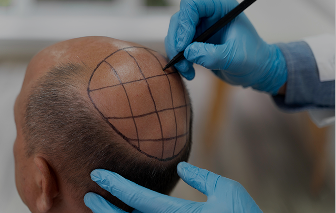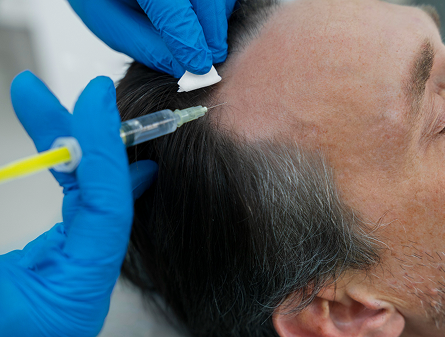Platelet-rich plasma (PRP) treatment takes blood from the patient and isolates the PRP to inject it into the scalp. The platelets can help stimulate the hair follicles and lengthen the growth phase of hair. A hair transplant is a surgical procedure where healthy hair is extracted from a donor area and implanted into the recipient/treatment area of balding or thinning.
These transplanted hairs will start to produce hair after 3 to 4 months. PRP treatments are not very invasive but do require experienced clinicians to perform them. Hair transplantation is more invasive and necessitates more care before and after the procedure to ensure the best results.
Check out the comparison table below to see if PRP or hair transplant treatments are suitable for you.
- PRP uses the patient’s blood to stimulate regrowth, offering a non-surgical option for early to moderate hair loss.
- PRP involves multiple sessions and low downtime.
- The treatment is progressive and natural-looking.
- Popular with those preferring less invasive care.
- Regular maintenance is required for PRP to sustain outcomes.
- Hair transplant is a surgical solution where follicles are relocated from a donor area to thinning spots.
- Hair transplant is ideal for those with advanced loss needing visible results.
- It involves one or two sessions with a recovery period.
- Suitable for patients with adequate donor hair.
- Hair transplant offers permanent restoration in treated areas.
- PRP is more affordable per session than a transplant, but costs increase with multiple treatments and ongoing maintenance.
- Compared to hair transplants, PRP may feel more manageable upfront, but often becomes costlier over time.
- Hair transplants require a significant one-time payment but usually need just one or two sessions.
- In contrast to PRP’s recurring fees, hair transplants’ one-off cost can make them more economical in the long term for suitable candidates.
- PRP sessions last 30–60 minutes and are typically done monthly across several months, with maintenance needed later.
- Unlike a hair transplant, PRP is short, low-effort, and requires no recovery but semi-regular upkeep.
- Hair transplants take 4–8 hours in one session, followed by a recovery phase.
- While more intensive up front than PRP, the long-term time commitment is lower since results are usually permanent after one procedure.
- PRP is a restorative method that provokes natural follicles by injecting platelet-rich plasma into the scalp.
- Unlike hair transplant surgery, it cooperates with the existing follicles rather than translocating new ones.
- Hair transplants transfer follicles from dense donor locations to bald spots.
- Unlike PRP, this creates new hair coverage instead of stimulating current follicles to grow.
- PRP is low risk due to its use of autologous plasma, with minimal side effects like slight redness or tenderness.
- Hair transplants involve surgical risks, including infection, scarring, or healing issues.
- Hair transplants carry the standard risks of surgery and require proper aftercare.
- While generally safe, they demand more from the patient post-procedure than PRP’s mild and temporary effects.
- PRP is defined by quick, office-based visits with no downtime; therefore, it can be easily integrated into a schedule.
- Unlike a hair transplant, it involves multiple visits, which can be less convenient for some clients.
- Hair transplants take time and may require leave from work for recovery, but usually only one or two sessions are necessary.
- Compared to the conventional commitment of PRP, many patients prefer the solitary procedure of the transplant.
- PRP is widely accessible in Australia and doesn’t rely on donor hair, making it suitable for more people.
- Unlike hair transplants, it is a non-surgical service in many aesthetic clinics.
- Hair transplants are only offered in specialised centres and require a strong donor area.
- In contrast to PRP, some users may not be eligible due to hair density or location limitations.
- PRP offers gradual improvements that can be sustained with consistent treatment.
- Unlike hair transplants, stopping sessions may lead to a return of hair thinning over time.
- Hair transplants provide permanent regrowth in treated areas, requiring little maintenance.
- Compared to PRP, this one-time solution appeals to users seeking longer-term results without repeated treatment.
- PRP can be paired with topical products and supplements, and is suitable after a hair transplant to improve results.
- Unlike transplants, PRP enhances existing follicles and complements other therapies well.
- Hair transplants are often combined with PRP to support healing and maximise results.
- Compared to PRP alone, the transplant offers physical restoration while PRP supports follicle vitality.
- PRP suits those who prefer minimally invasive care with steady, natural-looking progress.
- Unlike hair transplants, it offers subtle changes without drastic transformation.
- Hair transplants are ideal for individuals seeking a major, visible change after significant hair loss.
- In contrast to PRP’s subtle build-up, this approach gives more immediate confidence through restored coverage.
- PRP supports follicle health, improves circulation, and reduces scalp inflammation, making it ideal for slow, progressive thinning.
- Compared to hair transplants, it enhances existing hair rather than replacing it.
- Hair transplants restore lost density in bald areas but don’t directly improve surrounding follicle health.
- In contrast, PRP actively nourishes follicles to prevent further loss and support overall scalp health.
- PRP generates moderate waste from single-use syringes and multiple clinic visits, which adds to emissions over time.
- Compared to a one-time hair transplant, its recurring nature creates a larger footprint.
- Hair transplants use more resources in a single session but require fewer visits overall.
- Unlike PRP, the environmental impact is concentrated rather than cumulative, potentially lowering long-term waste.
Shop our hair solutions
We are committed to providing affordable hair regeneration services for people all over Australia. Our formula can help you regain your confidence.
Shop Now

Hair Transplant vs PRP Comparison Summary
PRP treatments can provide short-term results by improving the conditions on your scalp for optimal hair growth. The injections will need to be topped up to maintain the results. Hair transplants are a more long-term solution.
The grafts that are implanted into the treatment areas will continue to grow hair in the future. Depending on the extent of hair loss, future hair transplants may be required if the hair surrounding the recipient site falls out.
When it comes to PRP vs hair transplant costs the price of a hair transplant is a bigger initial investment compared to PRP sessions. This can be a more affordable solution in the long-term if PRP sessions are required continuously as the costs can add up whereas a hair transplant is typically a once-off cost.
A hair transplant is more of a time commitment as it requires a whole day for the procedure alongside the extensive recovery requirements while PRP treatments may be more suitable if you are looking for a short-term option for improving hair growth.
Hair Regrowth Solutions User Guidance
Hair transplantation is the more invasive treatment option however it provides more long-term results. While neither option is a permanent solution to hair loss, hair transplants may be more cost-effective in the long run.
For early stages of hair loss, PRP injections can help to inhibit hair shedding and improve the conditions on the scalp for optimal hair growth. If your hair loss has progressed beyond this you may be a good candidate for a hair transplant.
There are more risks associated with a hair transplant depending on the surgeon and clinic you choose compared to PRP injections. This means more research may be required compared to getting PRP injections as the results will likely not vary greatly between treatment providers.
Take Our Hair Loss Quiz to See Which Treatment Suits You?
Take A Hair Quiz

Frequently Asked Questions
We have put some commonly asked questions.
Nunc scelerisque tincidunt elit. Vestibulum non mi ipsum. Cras pretium suscipit tellus sit amet aliquet. Vestibulum maximus lacinia massa nontor.
Platelet-rich plasma (PRP) treatment involves drawing blood from the patient, isolating the beneficial nutrients and injecting it into the scalp where hair loss is occurring. This promotes hair growth and has many other applications from encouraging healing to skin rejuvenation.
Platelet-rich plasma (PRP) treatment involves drawing blood from the patient, isolating the beneficial nutrients and injecting it into the scalp where hair loss is occurring. This promotes hair growth and has many other applications from encouraging healing to skin rejuvenation.
Platelet-rich plasma (PRP) treatment involves drawing blood from the patient, isolating the beneficial nutrients and injecting it into the scalp where hair loss is occurring. This promotes hair growth and has many other applications from encouraging healing to skin rejuvenation.







 See All
See All